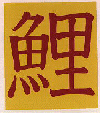
 There are actually many theories and dates relating to the
original introduction of the Koi. Theories go back thousands of years
but proof of actual dates and facts are varied and sketchy. The wild
carp has long been a symbol to Asian and Far Eastern countries and has
been evident in their paintings, pottery and carvings and even as part
of the handed down stories for generations.
There are actually many theories and dates relating to the
original introduction of the Koi. Theories go back thousands of years
but proof of actual dates and facts are varied and sketchy. The wild
carp has long been a symbol to Asian and Far Eastern countries and has
been evident in their paintings, pottery and carvings and even as part
of the handed down stories for generations.
There is much speculation regarding the coloured koi but nearly all
authorities agree that the koi we know today were developed on Japan and
were only recognised during the 19th Century. It is believed that the
first Koi colour was the red, then the white, then by breeding, the
first real mutation of the two coloured red and white was developed.
At this stage, these were called hi-goi but were later referred to as
goi or koi, either being correct. The Japanese actually use many name
 combinations when
explaining the varieties of Koi. The only reason why the Western
countries have not translated into English is that we would find it
extremely difficult to translate the names correctly and the
interpretation would not be as specific as in the Japanese language.
For example, the colour red is called hi so a red carp is called hi-goi,
as was first used. Likewise, Nishiki means coloured so that is how
Nishiki-goi was created. This is one of the more common and well used
names. As the Koi is such a part of Eastern society culture, the
Chinese and Japanese have created a symbol representing Nishikigoi.
combinations when
explaining the varieties of Koi. The only reason why the Western
countries have not translated into English is that we would find it
extremely difficult to translate the names correctly and the
interpretation would not be as specific as in the Japanese language.
For example, the colour red is called hi so a red carp is called hi-goi,
as was first used. Likewise, Nishiki means coloured so that is how
Nishiki-goi was created. This is one of the more common and well used
names. As the Koi is such a part of Eastern society culture, the
Chinese and Japanese have created a symbol representing Nishikigoi.
The mutations then became more involved and intricate to the stage
where in 1915, a tricoloured Koi was introduced at an exhibit in Tokyo.
It is thought that the tricolour breeding had at this stage been around
for about 25 years but as with most Koi evidence, there are no records
to prove this. Once the Koi reached this stage, Koi keeping and
breeding had become very popular in Japan, however it wasnt until after
World War II that Koi became popular in the Western worlds. At this
stage, prices were extremely high and Koi were only kept by the more
well to do people.
The next substantial development came in the early 20th century with an
arrival from Germany, being a mirror carp with reflective scales. This,
only with the final introduction of golden scales, bred from a wild carp
in about 1920, is the last of the known mutations.
Currently,the Japanese have many Koi Varieties but generally recognise as standard thirteen basic
colour forms and patterns. The finest Koi in the world are still found
in Japan but the Americans and Germans are now becoming good rivals in
the breeding circles. Koi breeding and keeping is finally becoming a
more wide spread hobby as the costs have dropped from comparing a single
koi to the price of a car to an everyday hobbiest being able to afford
quite a number of Koi for their pleasure.

© Copyright 1996-1998 By
Eduard Freeman